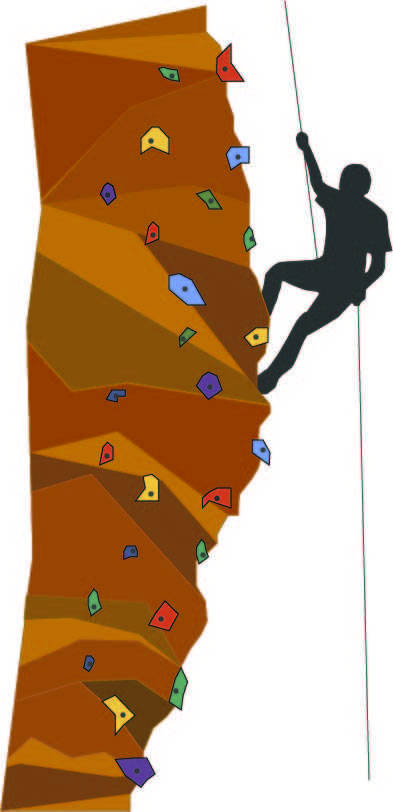A Philly rock climbing adventure
“So do you want to take a bouldering or top rope course?” The voice on the other end of the phone at the Philadelphia Rock Climbing Gym asked.
I had called the first indoor rock climbing gym I found on Google, simply to try something new.
The guy on the phone explained to me that bouldering was a solo, free climbing version of rock climbing, while top rope involved two people and harnesses.
I planned on going by myself so I told him that bouldering was what I wanted to do. After all, the ground is padded in the gym. I might not have been as adventurous if it were outdoor rock climbing.
I decided to go to Philadelphia Rock Gym’s East Falls complex. When I got there, I was handed a weird pair of form fitting rubber shoes that were fastened together by weak velcro straps.
After I finally got both straps to stay on, I met the two other students in my Intro to Bouldering class. They were two men in their mid-20’s. Alex Gomez, our instructor, guided us to the beginner’s wall.
The rock climbing area is a large warehouse covered in padded flooring that seemed to bounce under my feet while I walked. The walls were beige and covered in different colored plastic pegs. The beginner wall was less steep than the other walls and had some of the lowest climbing routes.
Gomez began the class by explaining the importance of mat placement. She dragged over a large padded mat and placed it near the wall, explaining that the mat needed to be placed below the highest part of the climb, which was about a foot or two away from the wall.
She then explained how to fall correctly. The first technique was the controlled fall, which involves landing in a crouched position with your hands between your legs, much like a baseball catcher’s stance except with your knuckles on the ground.
“The main reason for your hands being in between your legs is so that you don’t knee yourself in the face,” Gomez said. “You also keep your hands in fists so you don’t mess up your fingers.”
The next fall was the uncontrolled or, as Gomez put it, “the oh s*** fall.” She taught us that if we lose our balance and control, we should keep our bodies loose and try to land on our back with our arms out in front of us.
After these tips, we were let loose to begin climbing on our own.
I walked up to the first open wall, which seemed somewhat easy. I looked at the cluster of plastic pegs attached to the wall. It couldn’t be that hard, right?
I was wrong.
Rock climbing is not as simple as climbing up a wall. It takes a combination of upper body strength, stamina, and critical thinking.
My first mistake was not planning a route up the wall. Being able to figure out exactly where each appendage needs to go on the fly is a pivotal skill in rock climbing that I hadn’t anticipated. I routinely got stuck and was left dangling, looking for another peg on the wall. I immediately began to lose my grip and fall off the wall. The next few attempts were not as successful.
Derek Transue, the assistant operations manager at Philadelphia Rock Gym’s East Falls Complex, told me in an interview that there were certain characteristics that make a good rock climber.
“Balance is a good skill to have,” Transue said. “So is determination and the want to try the sport. Another key is the willingness to fall and a lot of climbing ends up being falling. Climbing is like Tetris for your muscles. So you’ll like rock climbing if you like puzzles.”
With much trial and error, I began to figure out what I had to do. I slowly began to ascend the side of a structure called the “Shipwreck,” which resembles a sunken ship.
I slowly made my way up and eventually was able to pull myself to the top. I sat on top of the wooden ship and looked around, feeling pretty good about my accomplishment.
As I finished up I began to watch the other, more experienced, climbers go about their work. I watched them do some impressive things like hang upside down and pull themselves all the way back up the steepest walls in the complex.
There was something inherently silly to me about seeing adults spend their time climbing walls. I imagined how these people spent their whole day at their desks and then would come here after work and just climb things, like a kid getting out of class for recess.
“Climbing is a workout for those people who hate counting reps,” Transue said. “It is for people who don’t want to stand around and count curl after curl. It focuses more on body movement and each climb is its own small workout within itself.”
As funny as it seemed at the moment, I too understood why people preferred to rock climb about 20 minutes after I finished. It is quite a workout; my arms and oddly my toes were very sore. My arms being sore made sense to me, but the constant digging of my big toe into the hard, plastic pegs had taken a toll.
Indoor rock climbing was definitely an interesting way to spend a Friday night. I did have fun, but for the cost of about $75, (the class was $45 but the Uber there and back was around $30) I’ll stick to the campus gyms for now.















































